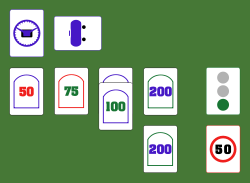- Mille Bornes
-
Mille Bornes 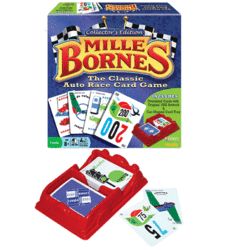
Modern editionManufacturer(s) Winning Moves Designer(s) Edmond Dujardin, born in Ecuador and raised in France Illustrator(s) Joseph Le Callennec Publisher(s) Winning Moves Publication date 1953 Genre(s) Take That Language(s) English / French Skill(s) required Medium Media type Cards Mille Bornes (English pronunciation: /ˌmɪl ˈbɔrn/) (French for a thousand milestones, referring to the stone distance markers on many French roads) is a French card game. In the United States, Mille Bornes is manufactured and distributed by Winning Moves Games under license from Hasbro. It was previously produced by Parker Brothers[1] and is commonly available in stores that sell games. Mille Bornes is listed in the GAMES Magazine Hall of Fame.
Contents
History
The game was created in 1954 by Frenchman Edmond Dujardin,[2] and was quite similar to the earlier American automotive card game Touring. A key innovation was the addition of the coup-fourré, whereby bonus points are earned by holding back a safety card (such as the puncture-proof tire) until an opponent plays the corresponding hazard card (in this case, the flat tire).[3]
Some Mille Bornes decks are printed in both English and French. The Spanish version Mil Hitos, distributed by Heraclio Fournier, was very popular in Spain during the 1970s.[citation needed] In the Netherlands there is a variant of this game, Stap op, which deals with cycling instead of driving.[citation needed] The hazards and distances are different, but the mechanics of the game are exactly the same.
Playing the game
- For detailed gameplay see associated article in WikiBooks
Object
The premise of Mille Bornes is that the players are in a road race. Each race—or hand—is usually 700 miles (or kilometers) long, but the first player to complete that distance exactly has the option to declare an extension in which case the race becomes 1,000 miles. Mille Bornes is played with a special deck of cards. There are hazard, remedy, safety, and distance cards. Each hazard is corrected by a corresponding remedy, and is actually prevented from happening in the first place by a corresponding safety. The target distance is reached by playing distance cards.
The Cards
- Hazards:
- Accident:3
- Out of Gas:3
- Flat Tire:3
- Stop:5
- Speed Limit:4
- Remedies:
- Repairs:6
- Gasoline:6
- Spare Tire:6
- Go:14
- End of Limit:6
- Safeties:
- Driving Ace:1
- Extra Tank:1
- Puncture Proof:1
- Right of Way:1
- Distance:
- 25 Kilometer:10
- 50 Kilometer:10
- 75 Kilometer:10
- 100 Kilometer:12
- 200 Kilometer:4
Also included in the deck are nonplayable cards that list the playable cards and summarize the scoring. In some decks, some of these are printed entirely in French.
Play
The deck is shuffled and 6 cards are dealt to each player; the remainder becomes a draw pile and a discard pile forms next to it. Each player's turn begins with a draw of one card and a play of one card, so that each player always holds 6 cards at the end of his turn. If he cannot play he must discard. Discarded cards are dead and cannot be taken for any reason.
Each player (or team) builds a tableau. The tableau is divided into battle, speed, distance, and safety areas; cards in the battle and speed areas are stacked so that only the top card shows. The example shows a typical tableau midway through a game.
Hazards and remedies (with the exception of Speed Limit and End of Limit) are played in the battle area, where a Roll card is shown in the example. Speed Limit and End of Limit cards are played in their own area. Distance cards are played according to value; it is common to play the 200-km cards distinctly, rather than fanned. Safety cards are played along the top of the tableau; note that the horizontal placement of the Extra Tank card in the example has a special significance.
In turn, a player may choose to play one of the following:
- A distance card on his own tableau if a Roll card is showing in his battle area.
- A remedy on top of the corresponding hazard if one is showing in his battle area.
- An End of Limit on top of a Speed Limit if one is showing in his speed area.
- A hazard on top of his opponent's Roll if one is showing and his opponent has not already played the corresponding Safety.
- A safety in his own safety area (at any time).
- A Roll card in his own battle area if a Stop or remedy is showing, or if his battle area is empty. Note that a hazard cannot be played unless one's opponent is moving, except for the Speed Limit.
Once an Accident, Out of Gas, or Flat Tire hazard has been played, and the appropriate remedy card played as a counter, the player must next play a Roll card in order to get moving again.
Playing a safety corrects the corresponding hazard and also protects against future hazards of this type. However, when the safety is played normally, a Roll must still be played before any distance cards. Whenever the safety is played, the same player draws another card immediately and plays again. It is possible to play another safety and another, each time drawing a card before playing again.
A player whose speed is limited (as shown in the example) may only play 25 and 50 km cards. No more than two 200 km cards may be played by any player or team in a single hand.
The Right of Way card both remedies and protects against Stop and Speed Limit hazards; if a player (or team) has played this card then he (or they) need not display a Roll card in order to move; any Stop or Speed Limit showing is removed to the discard pile at the time the Right of Way card is played. However, the player is still vulnerable to other hazards.
Players may always discard, even if they have a legal play available. A player who cannot play in any other way must discard.
Under no circumstances may a distance card be played that would put the player's total over the race goal of 1000 km.
Play continues until either:
- one player (or team) reaches exactly 1000 km in total distance cards, or
- all players have played or discarded all their cards.
Note that play continues after the draw pile is exhausted, each player playing or discarding one card per turn. Once both players run out of cards in their hand with a depleted draw pile, play ends.
Scoring
When a hand ends it is scored with the following points:
-
-
Scored by each side Distance 1 per km traveled Each safety 100 however played All 4 safeties 700 again however played (includes the 400 points for safeties) Coup-fourré 300 in addition to the 100 scored normally Scored only by side that completes trip Trip completed 400 for being the winner Delayed action 300 for completing the trip after the draw pile is exhausted Safe trip 300 for completing the trip without playing any 200 km cards Extension 200 for completing the trip after calling for an Extension Shutout 500 for completing a trip before the opponent has played any Distance cards
-
In a 2-player game, the maximum score that can be made in one hand is 4,600 points. In a standard 4-player game there is no extension, so the maximum score is 4,400. In a 3-player or 6-player game, two shutout bonuses are achievable, yielding a perfect score of 5,100.
Note that some points are scored even if a side does not complete a trip; it is possible for the completing side to score fewer points than their opponents. If the hand ends by exhaustion rather than by completion, each side still scores its distance and safety points.
According to the printed rules distributed by Parker Brothers, a game continues until one or both sides reaches a cumulative point total of 5,000. If both sides go over 5,000 during the same hand, the higher point total wins the game. When the game is played for fun the exact point total is irrelevant, so long as one is higher. Note that it is possible for the game to end in a tie, in which case the rules are silent.
If the game is played for money, then generally the point difference is paid from the loser to the winner, and every point is significant.
With larger or smaller groups
2, 3 or 6 Player play is possible with slight rule modifications. For detailed play see Wikibooks article.
Card images
Gallery of card images
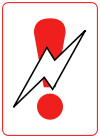
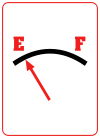
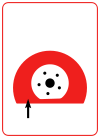
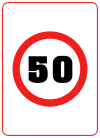
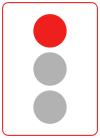



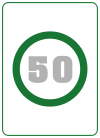

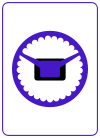
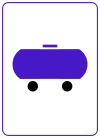
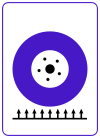

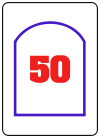

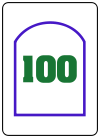

See also
References
- ^ Mille Bornes rules from Parker Brothers
- ^ Encyclopedia of Play in Today's Society, pg xxxviii, Rodney P. Carlisle Sage Publications (2009) ISBN 1412966701
- ^ History of "take that!" style dedicated-deck card games
External links
- Mille Bournes at SourceFiles.org game description, rules, and strategy notes
- The Mille Bornes Tournament Home Page description and rules
- Milestone on irc.globalgamers.net, Milestone on Internet Relay Chat.
Categories:- Dedicated deck card games
- Parker Brothers games
Wikimedia Foundation. 2010.

